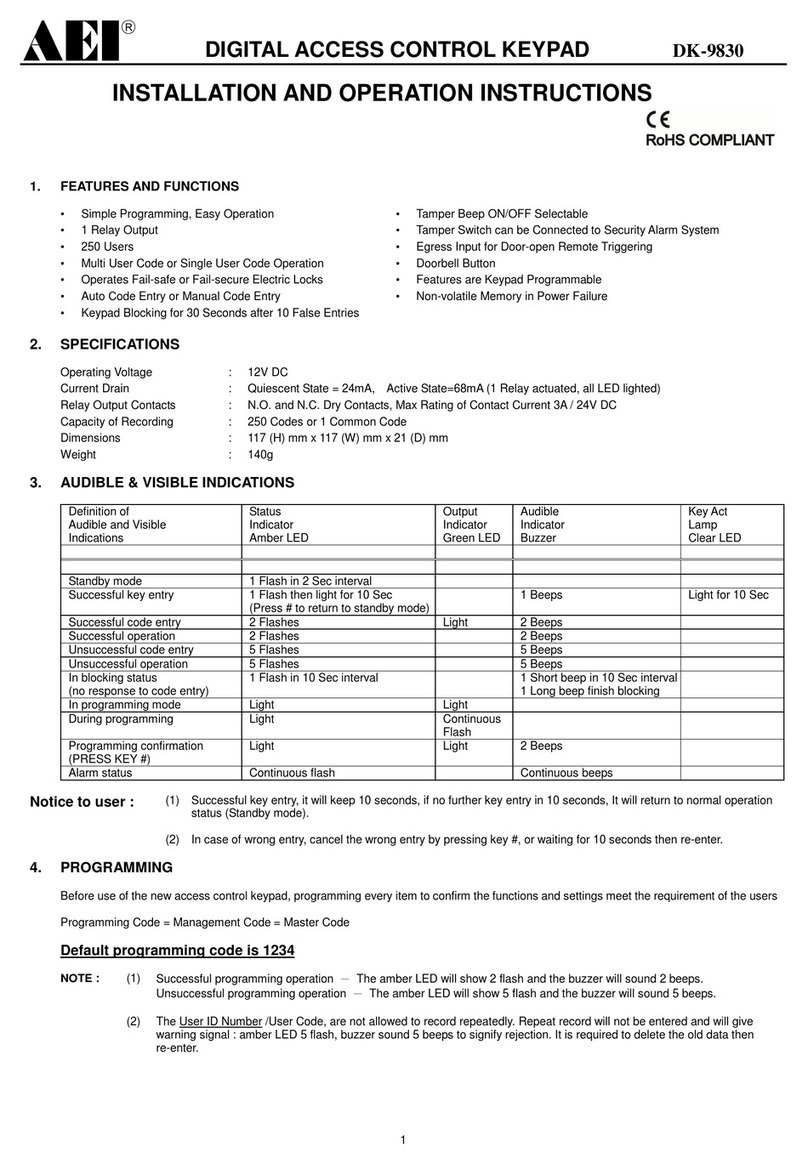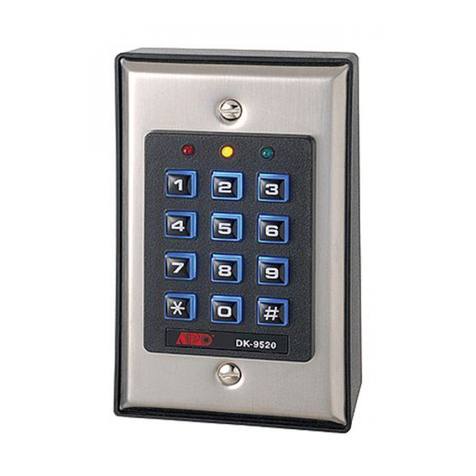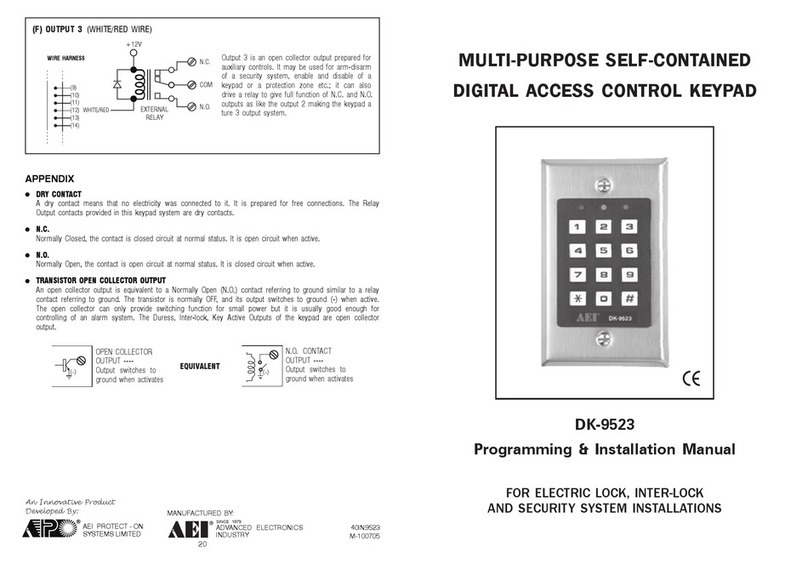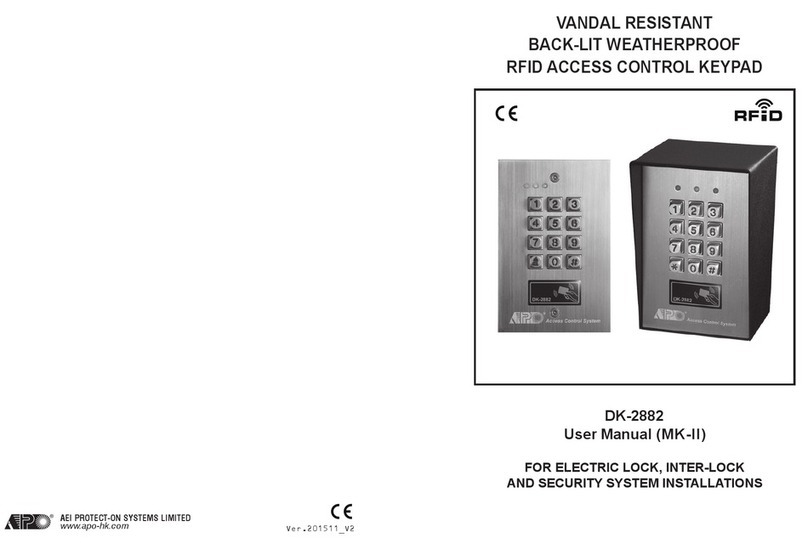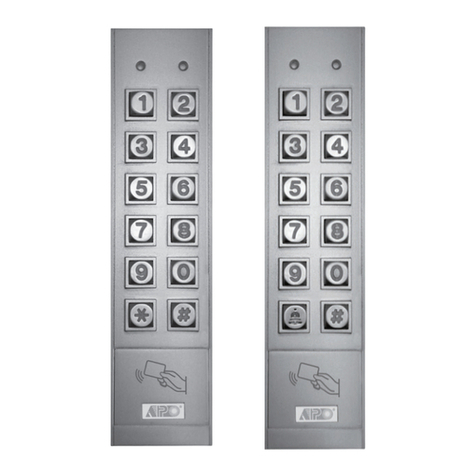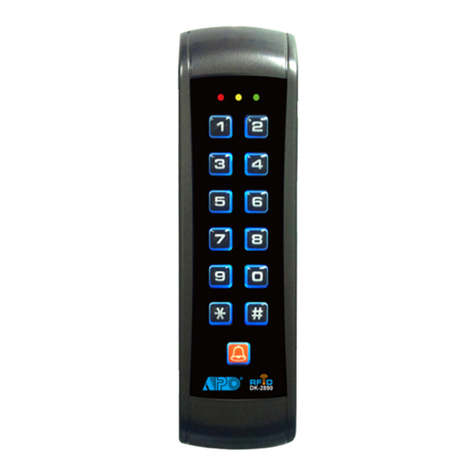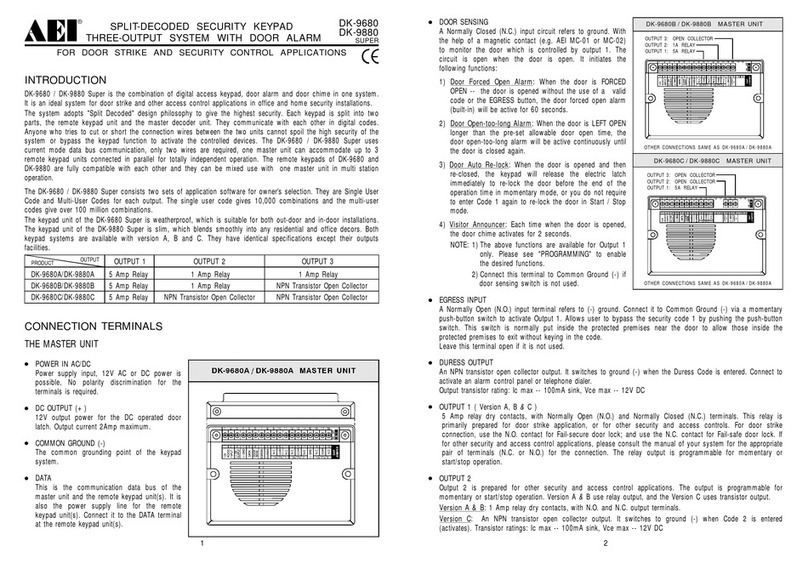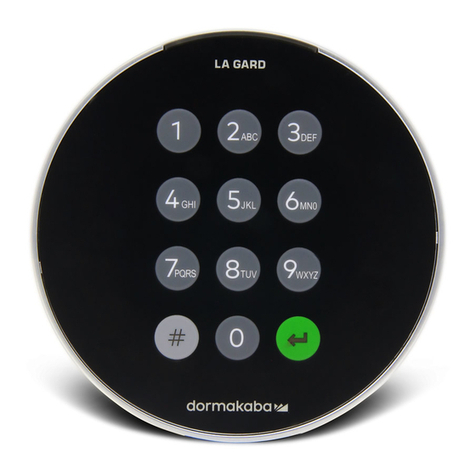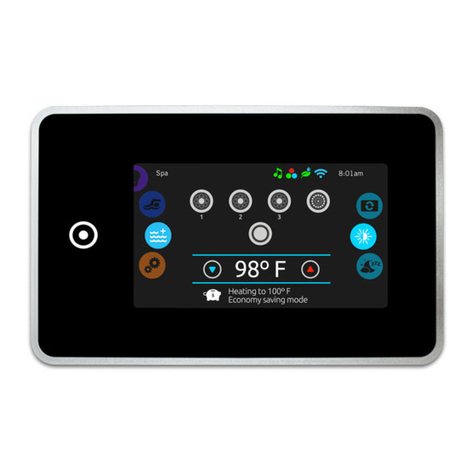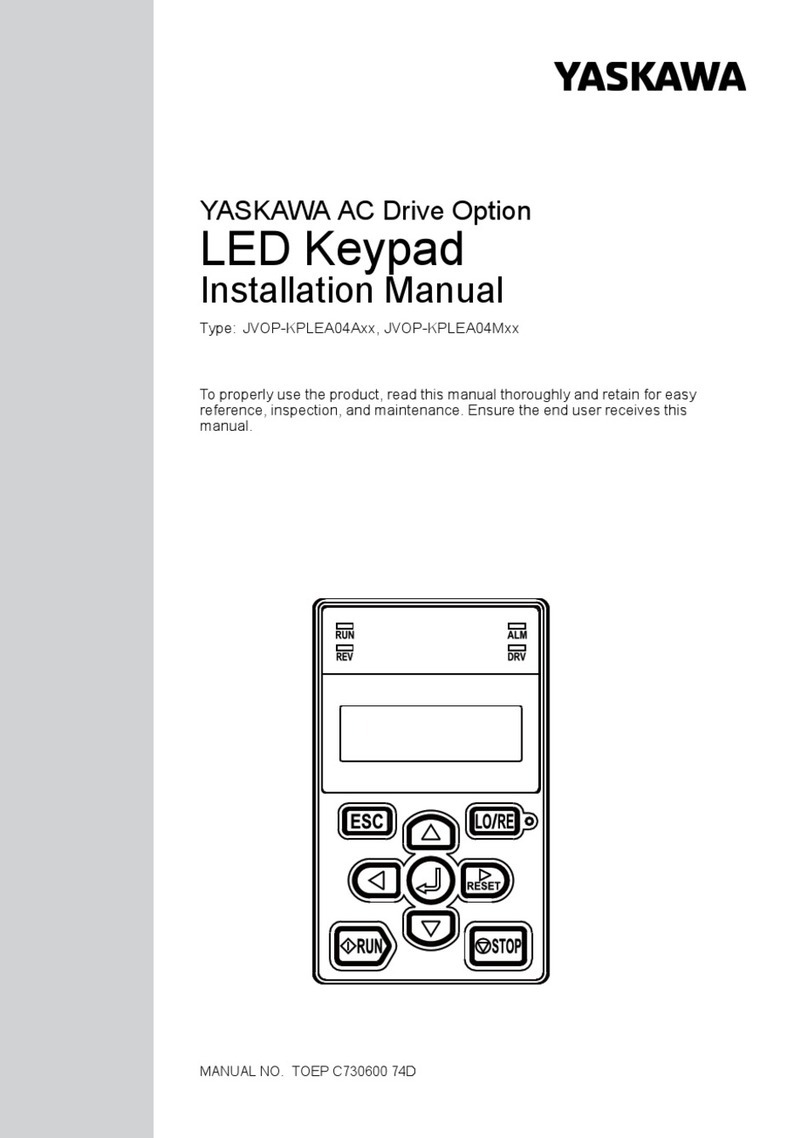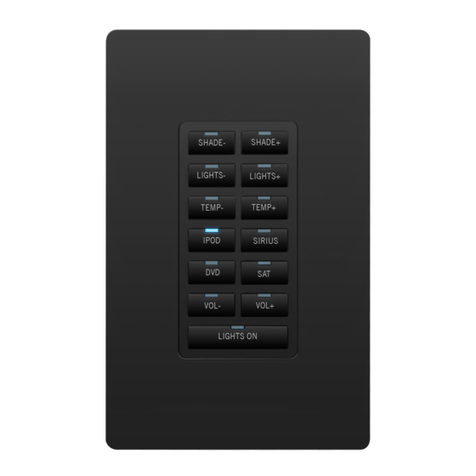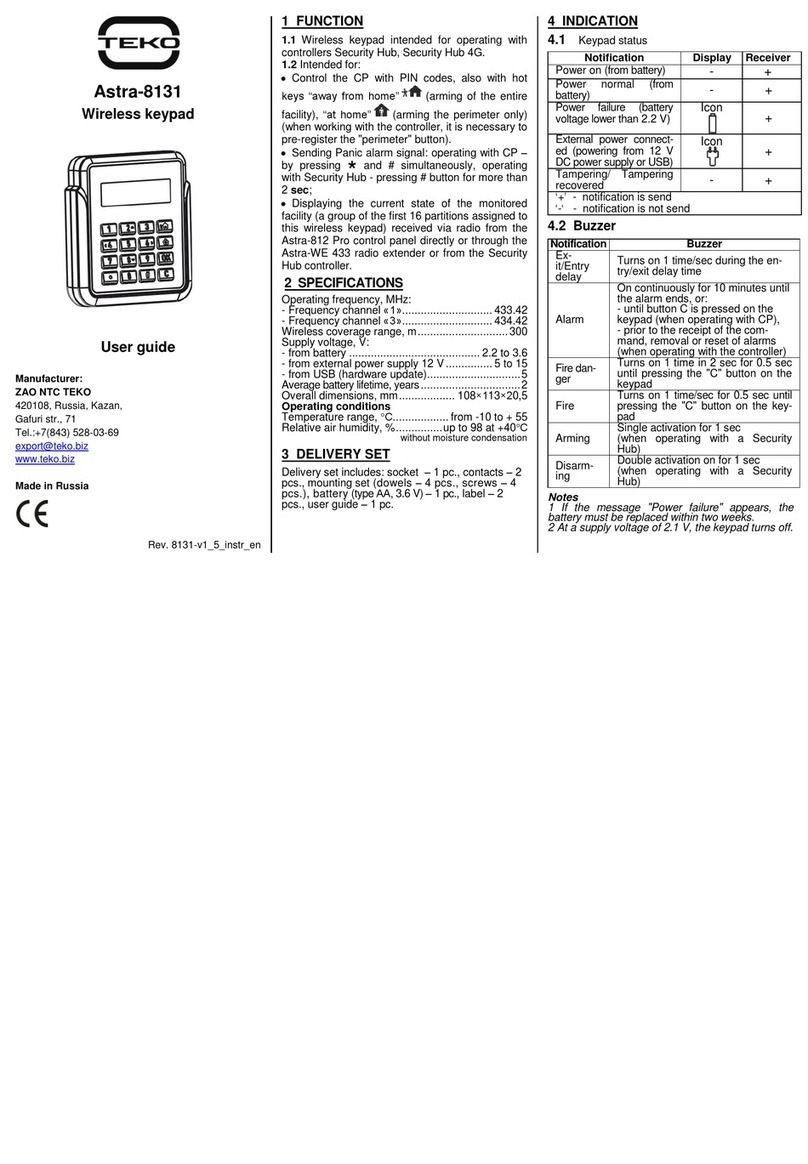AEI DK-2822 User manual

DK-2822
User Manual (MK-II)
FOR ELECTRIC LOCK, INTER-LOCK
AND SECURITY SYSTEM
RFID ACCESS CONTROL KEYPAD
DK-2822

TABLE OF CONTENTS
INTRODUCTION
FEATURES
OPTIONAL DEVICES FOR SYSTEM EXPANSION
SPECIFICATIONS
INSTALLATION
Precautions
CONNECTION TERMINALS
OTHER FACILITIES
On-Board LED Indicators
Pacifier Tone & The LED Signals
Jumper for Back-Lit Selection
PREPARATION FOR PROGRAMMING
A) Criteria for Codes and Cards
B) Security Level of The Operation Media
C) List of User Information
PROGRAMMING AND OPERATION
Power Up The Keypad
Set Keypad into Programming Mode with Master Code
Direct Access to Programming Mode with The “DAP” Code – 2 8 2 8
System Refreshing with “Refreshing Code” --- 9 9 9 9
The Default Values of The Keypad
Master Code
Super User Code
Operation and Functions of The Super User Code
Common User Codes for Output 1 & 2
User Codes/Card For Output 1 & 2
Examples – Programming And Operation
Visitor Codes (For Output 1 Only)
Duress Codes (For Outputs 1 & 2)
Operation And Function of The Duress Code
Output Modes & Timing for Output 1 and 2
System Real-Time-Clock
Start & Stop Times For Daily Inhibition of Output 1
Personal Safety And System Lock-Out
User Code Entry Mode - Auto or Manual
Pacifier Tones On-Off Selection
Output Operation Announcer
Status LED Flashing On-Off during Standby
Door Forced Open Warning & Timing
Door Propped-Up Warning & The Delay Time
Intelligent Egress Button – An Unique Feature of A Contemporary Keypad
Where And Why “Going Out” Needs Attention
Egress Delay , Warning And Alarm
2
······································································································································· 4
················································································································································ 4
·················································································· 5
···································································································································· 6
········································································································································· 7
············································································································································ 7
··············································································································· 8-11
································································································································ 12
······················································································································· 12
··········································································································· 12
················································································································· 12
····························································································· 13-14
·············································································································· 13
························································································· 13-14
····················································································································· 14
·································································································· 15-46
···························································································································· 15
·········································································· 15
························································· 16
··········································································· 16
········································································································· 17
·········································································································································· 18
···································································································································· 18
········································································ 19-20
······························································································· 21
···································································································· 22
·························································································· 23-25
···································································································· 26-27
······························································································· 28-30
················································································ 29-30
··························································································· 31
························································································································· 32
··········································································· 33-34
··································································································· 35
································································································ 36
·············································································································· 36
················································································································· 37
··························································································· 37
···································································································· 38
························································································ 38
········································39-40
·············································································39-40
··································································································· 41-42

Door Opening Alarm & Timer
Programming Locations For System Expansion
Wiegand Data Output Mode
Wiegand Data Output Format
Operation Modes
Close The Programming Mode
PROGRAMMING MAKE SIMPLE - For General Users
FACILITIES FOR WIEGAND OUTPUT
WIEGAND OUTPUT FORMATS
PROGRAMMING SUMMARY CHART
APPLICATION EXAMPLES
A Stand Alone Door Lock
An Inter-Lock System Using Two Keypads
APPLICATION EXPANSIONS
The Axiliary Readers & Keypad
The Split-decoders
1) Dual-station Access Control Door Lock
2) Multi-station Access Control Door Lock
3) Split-decoded Access Control Door Lock
4) Split-decoded Multi-station Access Control Door Lock
APPLICATION HINTS FOR THE AUXILIARY TERMINALS
AUXILIARY INFORMATION
3
·················································································································· 43
························································································ 44
··················································································································· 44
················································································································· 45
···································································································································· 46
················································································································ 46
····································································· 47-48
······································································································ 49
·········································································································· 50-53
································································································ 54-56
················································································································ 57-58
························································································································ 57
····························································································· 58
············································································································ 59-62
··············································································································· 59
·································································································································· 60
························································································· 61
·························································································· 62
························································································· 63
····································································· 64
································································ 65-67
····················································································································· 68

INTRODUCTION
FEATURES
DK-2822 MK-II is a self-contained full feature digital access control keypad that combines proximity
EM card reader in one unit. It can be flush mount on a single gang box or surface mount on its plastic
mounting box.
The keypad has two outputs. The output 1 is a solid state relay selectable to drive Fail-safe or
Fail-secure electric lock. Solid state relay gives longer service life and prevents sabotage of energizing
the output relay to open the door with a strong magnet. The output 2 is a standard relay with N.C.
and N.O. dry contacts for auxiliary controls or as a door bell button contact.
The keypad is employing the Tri-Tech design approach capable of system expansion. It works
perfectly in stand alone operation, split-decoded operation for security enhancement with the
optional decoder, and multi-station operation for user convenience with the auxiliary keypad-readers.
The keypad is ideal for access control and alarm system arm-disarm control. It is also a
programmable industrial timer (from 1 second to over 24 hours) for automatic operator system.
A member of the Tri-Tech series keypads compatible with the optional controllers & reader keypads
for system expansion
Loaded with the 2nd generation DK-2800 MK-II operation software
Built-in with all the logics for stand alone, split-decoded and multi-station operations
Controls “Going in” with User Codes / Cards and “Going out” with feature programmable egress
button
Independent control for the two output relays
Total 1,100 User Codes / Cards for controlling of the two outputs
Indoor installation
Stainless steel faceplate combines with plastic mounting box
26, 34 or 37 bit Wiegand data output
Package Contents
• One DK-2822 Keypad
• Two EM Cards
• One Pack of Mounting Screws
• One Programming & Installation Manual
4

5
Remark:
The suffix letter “S” stands for standard version and “A” stands for advanced version. The advanced
version possesses the standand features and also provides Wiegand and RS-232 data outputs for the
custom projects with external controller and PC.
Please contact your local agent for the optional devices.
OPTIONAL DEVICES FOR SYSTEM EXPANSION
The Optional Decoders Available for Split-decoded Operation
DA-2800 – Full Feature Decoder with RF Remote Control
DA-2801 – Full Feature Decoder
The Auxiliary Reader / Keypad Available for Multi-station Operation
AR-2802S or A – EM Card Reader
AR-2806S or A – EM Card Reader with Digital Keypad
AR-2807S or A -- EM Card Reader with Digital Keypad
AR-2809S -- EM Card Reader with Digital Keypad

SPECIFICATIONS
6
Operating Voltage:
12V DC Nominal; 11-15V DC
Operating Current:
60mA (quiescent) to 95mA
Operation Temperature:
-20 C to +70 C
Environmental Humidity:
5-95% relative humidity non-condensing
Working Environment:
Indoor use only
Number of Users:
Output 1 – 1,000 (PINs and/or Cards) + 50 Duress Codes
Output 2 – 100 (PINs and/or Cards) + 10 Duress Codes
Proximity Card:
Standard EM Card or Keyfob, 125Khz
Number of Visitor Codes:
50, programmable for one time or with the time limit
Timings for Code Entry and Card Reading:
10 seconds waiting for next digit entry
30 seconds waiting for code entry after card reading
The Timers:
Three 1-99,999 Seconds (Over 24 Hours possible) Independent Programmable Timers for O/P
1 & 2
Egress Button:
Programmable for Instant, Delay with Warning and/or Alarm
Momentary or Holding Contact for the Exit Delay
Input Sensing Terminals:
a) Door position, b) Egress, c) O/P 1 inhibit
Output Control Terminals:
Transistor Open Collector 24VDC/100mA sink Max for the following outputs
a) Duress, b) Alarm, c) Key Active, d) Output 2 (Door Bell version only), e) Inter-lock
Output Contact Ratings:
Output Relay 1 – Solid State Relay, Fail-safe or Fail-secure selectable, 3A/16VDC Max
Output Relay 2 – N.C. & N.O. dry contacts, 1A/24VDC Max. (N.O. contact only for Door Bell
version)
Tamper Switch – N.C. dry contact, 50mA/24VDC Max.
Dimensions:
117(H) X 74(W) X 48(D)mm
Weight:
200g net
Housing:
ABS Plastic Box
Specications are subject to change for modication without notice

INSTALLATION
ASSEMBLY
Make sure the location for installation has no strong low frequency electro-magnetic wave. Especially
in the range of 100-200Khz
If there is more than one keypads with the same operation frequency installed closely in the
location, make sure that they are at least 60cm (2ft) apart from each other to prevention
interference.
Do not apply power to the system while it is in installation.
Check carefully all the wirings are correct before applying power to the system for testing.
1) Prevent Interference:
The EM Card reader is working at the frequency of 125Khz. Installation precautions are necessary.
2) Prevent Accidental Short Circuit:
In the previous experience, most of the damages caused in the installation are accidental touching
of the components on circuit board with the wires carrying power. Please be patient to study the
manual to become familiar with the specifications of the system before starting the installations.
7
PRECAUTIONS
AMBER
RED/GREEN
RED/GREEN
FIXING
SCREWS X 2
DK-2822
DK-2822
VERSION B
VERSION A

CONNECTION TERMINALS
1 - 2 : TAMPER N.C. (Tamper Switch Normally Closed Contact)
A normally closed dry contact while the keypad is secured on its box. It is open while keypad is
separated from the box. Connect this N.C. terminal to the 24 hour protection zone of an alarm system
if necessary.
3 - 4 : 12V DC (Power Input Terminal)
Connect to 12V DC power supply. The (-) supply and the (-) GND are the common grounding points
of the system.
5 : (+) 12V Power Supply for The Lock
A (+) supply point for the electric lock, which is common to terminal 3.
6 : (–) Power Supply for The Lock (Output Contact for Door Lock Strike)
A 3 Amp rating solid state switch output contact for electric door lock strike, it switches to (-) in
operation. It is selectable for operating Fail-safe or Fail-secure electric lock via jumper setting.
Connect the negative side (-) of the electric lock to this terminal and the positive side (+) to terminal
5. The operating time of the contact is programmable. See Location 51.
Important --- Set Output Mode for Door Lock
Two types of electric locks are available on the market. It is necessary to confirm that the lock is
Fail-safe or Fail-secure in order to make the correct jumper selection. Wrong selection may cause
damage to the lock or the reader.
Fail-safe Electric Lock – Normally energized; power ON to lock, power OFF to unlock
Fail-secure Electric Lock – Normally de-energized; power ON to unlock, power OFF to lock
8
DOOR LOCK
SELECTION
JUMPER
K OR A JUMPER
BACK-LIT JUMPER
CONNECTION
TERMINALS
WIEGAND WIRE
HARNESS

7 : Data I/O Port
A bi-directional data communication port prepared for the connection of auxiliary keypad-readers
and split-decoder to expand the functions and features of the access control system.
8 : EG IN ( Egress Input)
A Normally Open (N.O.) input terminal referring to (-) ground. With the help of connecting a
normally open button to activate Output 1 for door opening like using Codes/Cards.
Egress button is usually put inside the house near the door. More than one egress buttons can be
connected in parallel to this terminal. Leave this terminal open if not used.
See Programming Locations 90 and 91 for more information about the Egress Button with
programmable features.
9 - 10 - 11 : OUTPUT 2 (Output Relay 2)
1 Amp relay dry contact controlled by the Group 2 User Codes or Cards for Output 2 in the version
“A” keypad, it is an auxiliary output contact for controlling security system or automatic operator.
Terminal 9 is Normally Closed (N.C.), terminal 11 is Normally Open (N.O.) and terminal 10 is the
common point of the two contacts. It is programmable for Start/Stop (toggle) mode or Momentary
with timing. See programming Location 52 for the details.
9 : OUTPUT 2 (Open Collector Output)
An NPN transistor open collector output is for the version “B” keypad, which is controlled by the
Group 2 User Codes/Cards. It has the maximum power rating of 24VDC/100mA sink. It is equivalent
to an N.O. (Normally Open) terminal referring to ground. It can be used to drive small power device,
such as a relay or a low power control point of other equipment. This output point is programmable
for Start/Stop (toggle) or Momentary with timing. See programming Location 52 for the details.
10 - 11 : DOOR BELL (Relay Contact for Door Bell)
Door Bell output is for version “B” only. It is a Normally Open (N.O.) relay dry contact with maximum
rating of 24VDC/1Amp. It is a triggering contact of a low voltage door chime. The contact point
keeps close as long as the bell button on the keypad is pressed.
9
Door Lock Selection Jumper
DOOR LOCK
2. SECURE (For Fail-secure Electric Lock)
1. SAFE (For Fail-safe Electric Lock)

10
13 : DU OUT (Duress Output)
An NPN transistor open collector output with maximum power rating of 24VDC/100mA sink. It is
equivalent to an N.O. (Normally Open) terminal switching to (-) ground after the Duress Code is
entered. Use it to trigger an alarm zone of a security system, or turn on a buzzer to notify a guard.
14 : (-) GND (Common Ground)
A grounding point of the keypad that is common to terminal 4.
Keypad Active Output (“K”) --- It switches to (-) ground for 10 seconds on each key touch. It
can be used to turn on light, CCTV camera, or buzzer to notify a guard. See Application Hints for
more information.
Alarm Output (“A”) --- It switches to (-) ground while Alarm occurs in order to trigger external
alarm to give notification at remote location.
KEY-ALARM JUMPER
K OR A
KEY ALARM
15 : DOOR SENS N.C. (Door Position Sensing Input -- Normally Close)
A Normally Closed (N.C.) sensing point referring to (-) ground, with the help of a normally closed
magnetic contact monitors the open or close status of the door. It initiates the following functions for
the system. Connect it with jumper to (-) Ground if not used.
a) Door Auto Re-lock
b) Door Forced Open Warning
c) Door Propped-up Warning
The system immediately re-locks the door after it is re-closed before the end of the programmed
time for output 1. It prevents unwanted “tailgate” entry.
The keypad generates “door forced open” warning and alarm instantly once the door is forced to
open without a valid user Code, Card or egress button. The warning lasts as long as the time
programmed (1-999 sec). It can be stopped with an User Code or card for output 1 at anytime.
See programming Location 80 for the details.
The keypad generates propped-up warning beeps (does not activates alarm output) while the
door is left open longer than the allowable time programmed. The warning will last as long as the
door is open until re-closed. See programming Location 81 for the details.
12 : “K” OR “A” O/P (Keypad Active Output or Alarm Output)
An NPN transistor open collector output with maximum power rating of 24VDC/100mA sink. It is
equivalent to an N.O. (Normally Open) terminal referring to ground. It can be used to drive small
power device, such as a relay or a low power control point for other equipment. This output point is
selectable to give Keypad Active Output or Alarm Output via the “K or A” jumper.

16 : O/P 1 INHIBIT N.O. (Output 1 Inhibit Control Input – Normally Open)
A Normally Open (N.O.) sensing input point for controlling the Output 1, with this terminal
connecting to (-) ground, the Egress Button, the group of User PINs and Cards for Output 1 are
all disabled. It is prepared mainly for the cross wire connection with the “Inter-lock O/P” point of
the partner keypad in an Inter-lock system.
NOTE: The inhibit function does not govern the Duress Codes and the Super User Codes. They are
17 : INTER-LOCK O/P (Inter-lock Control Output)
An NPN transistor open collector output with maximum power rating of 24VDC/100mA sink. It is OFF
at normal condition and it switches to (-) ground immediately for the first 5 seconds after keying in
a valid User Code or reading a card to operate Output 1, then, it will keep tying to (-) ground during
the Door Position Sensor is open circuit due to door opening. Use this output point to make cross
wire connection with the partner keypad’s “O/P 1 Inhibit” point in an Inter-lock system to prevent
both doors can be opened at the same time.
An Inter-lock System:
An inter-lock system is a two-door system that always allows only one of the doors to open during
the operation. While one of the doors is opened, the other door keeps close until the open door is
re-closed. It prevents the unauthorized people dashing into a protected area while the doors are in
use.
An inter-lock system needs two keypads and two door position sensing switches for the two doors.
always valid.
11
d) Inter-lock Control
The inter-lock control output always goes to (-) while the door is open, which gives signal to disable
the partner keypad in an inter-lock system. See the Inter-lock terminal 18 description for more
information.
e) Door Opening Alarm
Door Opening Alarm is designed for the emergency door only. It is always given when the door is
opened unless a valid user code or card is used prior to the door is opened. See programming
Location 91 for the details.

ON-BOARD LED INDICATORS
RED / GREEN (Right) ---
AMBER (Centre) ---------
RED/GREEN (Left) -------
PACIFIER TONES & THE LED SIGNALS
The buzzer and the amber LED indicator give following tones and signals respectively for system
status:
12
It lights up in Green for Output 1 activation; and Red for Output 2
activation.
It flashes in Standby. It shows the system status in synchronization
with the beep tones. The standby flashing can be OFF with
programming. See Location 73 for the details.
It lights up in Red while one of the outputs is inhibited. It is flashing
during inhibition paused.
It is the Wiegand LED for feedback indication. It lights up in Green.
NOTE:
*
* *
* * *
JUMPER FOR BACK-LIT SELECTION
1) Full Back-lit ---
2) Auto Back-lit ---
All Pacifier Tones can be ON or OFF through the programming option at Location 71
The Output Relay Activation beep can be selected through the programming option at
Location 72
The Standby flashing can be ON or OFF through the programming option at Location 73
The keypad gives dim backlit in standby. It
turns to full backlit when a key button is
pressed, then back to dim backlit 10
seconds after the last key button is
pressed.
The backlit is OFF in standby. It turns to
full backlit when a key button is pressed,
then back to OFF 10 seconds after the last
key button is pressed.
FULL AUTO
BACK-LIT JUMPER
OTHER FACILITIES
STATUS TONES * AMBER LED
1) In Programming Mode ----- ON
2) Successful Key Entry 1 Beep 1 Flash
3) Successful Code / Card Entry 2 Beeps 2 Flashes
4) Unsuccessful Code / Card Entry 5 Beeps 5 Flashes
5) Power Up Delay Continuous Beeps Continuous Flashes
6) Output Relay Activation ** 1 Second Long Beep
7) In Standby *** ----- 1 Flash in 1 Second Interval
8) System Refreshing ----- Fast Flashes for 2.5 Minutes
Continuous 3 Fast Beeps
/5 secs -----
Continuous 1 Beep/1 sec
11) Real -time-clock stopped after
power failure
10) Keypad link-up with Decoder Failed
)9 Card or Code Already Stored in
System
1 Long Beep
-----
-----
-----

13
PREPARATION FOR PROGRAMMING
A) CRITERIA FOR CODES AND CARDS
1) Prime Codes
The prime codes include the a) User Codes, b) Master Code, c) Duress Codes, d) Super User Codes,
e) Common User Codes and f) Visitor Codes. All these codes MUST be unique. It is not allowed to
repeat a prime code for second function.
All the codes in this system can be 4-8 digits for Manual Entry Mode. The codes must be in the same
digit length with the Master Codes for Auto Entry Mode. See Location 70 for the details.
2) Prime Cards
All the User Cards are prime cards. They are not allowed to program for second function. e.g. a card
was programmed for operating output 1 is not allowed for output 2.
The cards used in this system are 125Khz proximity EM cards.
3) Secondary User Codes
A Secondary User Code is prepared to enhance the security of an user card, which is a code put after
a card. The keypad requires both card and code are correct to grant an entry. The secondary code
can be repeatedly used for a group of cards; or proprietary with one code for one card.
NOTE:
The keypad will reject repeated use of prime card or prime code in programming and give one long
beep indication.
B) SECURITY LEVEL OF THE OPERATION MEDIA
The keypad provides 5 operation Media for owner’s selection of security level. See programming
Location 10 & 20.
1) EM Card Only – Operation Media 1
A general way for access control, just simply read a card to open the door. Security level is moderate
but it is user convenient.
2) User Code Only – Operation Media 2
A general way for access control, just simply enter a code to open the door. Security level is
moderate but it is user convenient.
3) EM Card + Common User Code – Operation Media 4
The keypad requires both Card and Common User Code are correct to grant an entry. Common User
Code is an user code for all the cards. Two media are used in door control. The security level is better
than just card or user code alone.
This operation mode can also report Duress Alarm by keying the duress code instead of common
user code in emergency when the user is forced to open the door.
4) EM Card + Group Secondary User Code – Operation Media 3
A secondary user code can be repeatedly used for a group of cards in a department. Owner can
make a proprietary department code for each department in a company. Only the staff of the
department holding a card and knowing the code is accepted to enter. This approach increases the
departmental security and prevents a lost card picked up by other group of people in the company
to open the door.
This operation mode can also report Duress Alarm by keying the duress code instead of common
user code in emergency when the user is forced to open the door.

14
Example:
User
Common
24680
1234
/
Output 1
Output 1
Output 2
Output 1
003
002
/
001
003
002
001
001
4
3
2
1
10
10
20
10
Tracy
Tom
May
John
Name Location Media User ID Code Card # Remark
1
2
3
4
5
6
7
8
9
10
11
12
13
14
15
16
--
1,000
C) LIST OF USER INFORMATION
The keypad can accommodate up to 1,200 users (codes / cards). To avoid confusion and for
programming convenience, it is suggested to make a list recording of the user information. It helps
the owner to program the user codes and cards smoothly and to trace them afterwards in the future.
Here is a suggested format of the list.
List of Users (See page 22-25 for reference)
5) EM Card + Proprietary Secondary User Code – Operation Media 3
The keypad accepts programming with each card having its own proprietary user code to work. It
prevents any other people can use the lost card to open the door. Card with proprietary user code
approach is ideal for the area that high security is the main concern.
This operation mode can also report Duress Alarm by keying in the duress code instead of
Secondary user code in emergency when the user is forced to open the door.

15
SET KEYPAD IN PROGRAMMING MODE WITH MASTER CODE
It is always necessary to set the keypad in programming mode for feature programming
The keypad is in normal operation after power-up delay. Set it in programming mode with Master
Code and validate it with or .
MASTER CODE VALIDATION
NOTE:
a) For those keypads with door bell button, the button is equivalent to the button.
b) For the owner’s convenience in programming at the first time, a Master Code 0 0 0 0 has been
put into the keypad before exit-factory. It is NOT a default code. For security reason, owner
should program a personal Master Code to replace it after the keypad is owned.
c) The Mains LED (amber) is ON after the keypad confirms it in programming mode with 2 beeps.
d) DO NOT turn off power while the keypad is in programming mode. Otherwise, it may cause error
to the data in memory.
PROGRAMMING & OPERATION
POWER-UP THE KEYPAD
The keypad gives power-up delay of 1 minute after power has been applied. It is the time frame
designed for setting the keypad to programming mode with DAP code. See the details of “DAP
CODE – 2 8 2 8” below.
1) The keypad gives continuous beeps for 1 minute after power-up.
2) The power-up delay can be stopped instantly with if the delay beep is found annoying
and setting the keypad to programming mode with DAP code is not required.
3) The keypad will set itself to Normal Operation Mode automatically after the 1 minute power-up
delay expired or it is stopped with .
POWER-UP DELAY STOP VALIDATION

16
5) To program a new Master Code to replace the old one. See “Record A Master Code”stated at
“Location 01” for the details.
NOTE:
The keypad will set itself to normal operation mode 1 minute after power-up if the Egress Button is
not pressed and the DAP code is not keyed in. To set keypad back to power-up mode, repeat
procedures 1-4.
SYSTEM REFRESHING WITH “REFRESHING CODE” --- 9 9 9 9
The keypad can be refreshed by cleaning all the programmed old data and set it back to default
values except the Master Code.
REFRESHING CODE VALIDATION
NOTE:
a)
b)
c)
Make sure that system refreshing is really required before entering the refreshing code.
Refreshing takes few minutes. The status LED (amber) keeps flashing during refreshing.
The keypad is back to its default value after refreshing. Re-program of the desired values are
necessary.
DIRECT ACCESS TO PROGRAMMING MODE WITH “DAP” CODE -- 2 8 2 8
In case the Master Code is forgotten, apply the following procedures precisely to set keypad
into programming mode with DAP code:
1)
2)
3)
4)
Switch OFF all the power for 1 minute to ensure that the keypad is fully discharged.
Switch ON power again. The keypad is in Power-up Mode for 1 minute. The buzzer gives
continuous beeps and the Status LED is flashing. This is the only time frame to accept the DAP
code.
Press the Egress Button (the button connecting accross EG IN (Terminal 8) and (-)GND (Terminal
4) once to enable the keypad for accepting DAP code. The power-up beep stops after the Egress
Button is pressed.
Key in the DAP code and validate it with (or ). The Status LED is
ON and the keypad is in programming mode like using Master Code. It is ready to accept new
programming data as long as you like until exit programming mode.
PRESS ONCE
EGRESS BUTTON DAP CODE VALIDATION

17
LOCATION PARAMETERS DEFAULT FUNCTIONS & VALUES
0 1 Master Code 0 0 0 0 Factory Set, Not a default value *
0 2 Super User Codes Nil ----- User Program Required
0 3 Common User Code 1 Nil ----- User Program Required
0 4 Common User Code 2 Nil ----- User Program Required
1 0 User Codes & Cards for O/P 1 Nil ----- User Program Required
2 0 User Codes & Cards for O/P 2 Nil ----- User Program Required
4 0 Visitor Codes Nil ----- User Program Required
4 1 Duress Code for O/P 1 Nil ----- User Program Required
4 2 Duress Code for O/P 2 Nil ----- User Program Required
5 1 O/P Mode of The O/P 1 Time = 5 Sec, Momentary
5 2 O/P Mode of The O/P 2 Time = 5 Sec, Momentary
5 6 Start & Stop Time Nil ----- User Program Required
5 5 System Real-Time-Clock Nil ----- User Program Required
9 3 Wiegand Output Format Code = 1, 26-Bit
9 4 Operation Modes Code = 0, Keypad Mode
6 0 Personal Safety & Lock-out Code = 1, 10 False Code/Card Lock-out 60 Sec
7 0 User Code Entry Mode Code = 2, Manual Entry Mode
7 1
7 2 O/P Operation Announcer
7 3 Status LED Standby Flashing ON-
OFF
Code = 1, Flashing Enabled
8 0 Door Forced Open Warning & Timing Code = 0, Warning Disabled
8 1 Door Propped-up Warning & Delay Code = 0, Warning Disabled
9 0 Egress Delay & Warning
9 1 Door Opening Alarm & Timer Code = 0, Alarm O/P Disabled
9 2 Wiegand Output Mode Code = 1, Disabled
Code = 1, Pacifier Tone ON
Code = 1 Sec, Notification Beep ON
Pacifier Tones ON-OFF Selection
Code 1 = 1, Momentary Contact without Warning
Code 2 = 0, Instant, No Delay
THE DEFAULT VALUES AFTER REFRESHING
NOTE:
The DAP Code 2 8 2 8 and the Refreshing Code 9 9 9 9 are fixed in the operating system program.
It can not be changed in any ways.

SUPER USER CODE (Location 02)
The Super User Code has TWO functions. It is prepared to operate the two outputs and make
operation of inhibit enable / disable to those outputs.
(1) LOCATION
Key in Location
(2) SUPER USER CODE
The Super User Code can be 4 to 8 digits.
When a new Super User Code is keyed in and confirmed, the old one is replaced.
(3) VALIDATION
Pressing key to confirm code entry.
18
4 to 8 Digits
MASTER CODE (Location 01)
LOCATION MASTER CODE VALIDATION
(1) LOCATION
Key in Location
(2) MASTER CODE
(3) VALIDATION
Master Code is the authorization code for setting the system to programming mode. It is NOT
an User Code operating the output relays.
The Master Code can be 4 to 8 digits.
When a new master code is keyed in and confirmed, the old master code is replaced.
The master code is also the Link-up Code between the keypad and the optional decoder in
Split-decoded operation.
(2)(1) (3)
Press key once. Two-beep confirms the entry.
Example:
Set a Master Code “2 2 3 3” ----
Example:
a) Set a Super User Code “2 5 8 0” ----
b) Deleted a Super User Code from memory: Key in the Location number and #. ----
4 to 8 Digits
(1) (2) (3)
LOCATION SUPER USER CODE VALIDATION

19
OPERATION AND FUNCTIONS OF THE SUPER USER CODE
1) Operate Output 1 and 2
The operation of the Super User Code is just like a normal User Code. Simply key-in the Code with a
specific output number for the desired Output. The Super User Code can also be used to reset an
operating output timer instantly.
---------- Output 1 Activates or Resets
---------- Output 2 Activates or Resets
Optional Functions Controlled by Super User Code for Output 1
Apart from controlling of the three outputs 1 and 2; the Super User Code can also be used to enable
the optional functions controlling Output 1 for user convenience or security enhancement.
Super User Code and Egress Button are excluded from any system inhibition and lockup functions;
they are valid for door open at anytime for safety.
2) Override The Door Lock Controlled by Output 1 (Keep Door Un-locked)
The Output 1 is usually for door lock control. In some situations, the door may require un-locked for
a period of time to allow door opening without User Code or EM Card for entry / exit convenience.
This function Starts / Stops in toggle with the following code entry.
---------- The Door is Un-locked, Start / Stop in Toggle
NOTE :
•
•
•
•
SUPER USER CODE
SUPER USER CODE
SUPER USER CODE
The door is un-locked while the function is enabled. The “Output 1” LED (Green) turns ON.
Do not forget to stop this function after use because the door is un-locked. Also, the system
refuses the optional functions (3) & (4) while Override function comes into effect.
This feature is good for all the “Fail-safe electric locks”.
“Fail-secure electric lock” requires power to keep in un-locked condition. It takes high current
all the time while the function comes into effect and may cause damage to it. This function is not
recommended for Fail-secure electric lock.

SUPER USER CODE
3) Pause The Scheduled Daily Inhibition for Output 1 (Temporarily Disable The Inhibition)
The scheduled inhibition can be programmed and applied to Output 1 with daily start and stop times.
It can be stopped temporarily if required; such as the staff work overtime after office hours going
into the inhibition period. This function Starts / Stops in toggle with the following code entry. It can
be done before or during the inhibition period.
---------- Door Lock Operation Resumes, Start / Stop in Toggle
NOTE :
• The “INHIBIT” LED (Red) is ON in inhibition and turns to Flashing while pause is into effect.
• See Programming Locations 55 & 56 for more information Daily Inhibition.
4) Inhibit All The User Codes & EM Cards for Output 1 (Disable Access Control Manually)
To enhance the security of the access control keypad, the owner can stop the keypad after office hour
or while the house is nobody inside. Once the Output 1 (for door lock control) is inhibited, all the User
Codes / Cards for it become invalid and those people holding the User Code or Card are refused. This
function Starts / Stops in toggle with the following code entry.
------ Door Lock Operation Inhibited, Start / Stop in Toggle
NOTE :
• The door is locked during Output 1 inhibited and the “INHIBIT” LED (Red) is ON.
• Inhibition applies to all User Codes and EM Cards for Output 1 only. Output 2 is not affected.
SUPER USER CODE
20
REMARK :
While SUPER USER CODE is in operation to hold the door lock open, the functions that
rely on the door sensor (such as a magnetic contact) and the User Codes for output 1 are all
temporarily suspended until SUPER USER CODE is keyed in again to release the door hold
function.
The following are the temporarily suspended functions:
Door Auto-relock
Door Forced Open Warning (at Location 80)
Door Propped-up Warning (at Location 81)
Door Opening Alarm (at Location 91)
Dual Keypad Inter-lock Operation
All User Codes Including Super User Code for Output 1
Duress Output Actuated by The Duress Code for Output 1
Table of contents
Other AEI Keypad manuals
Popular Keypad manuals by other brands
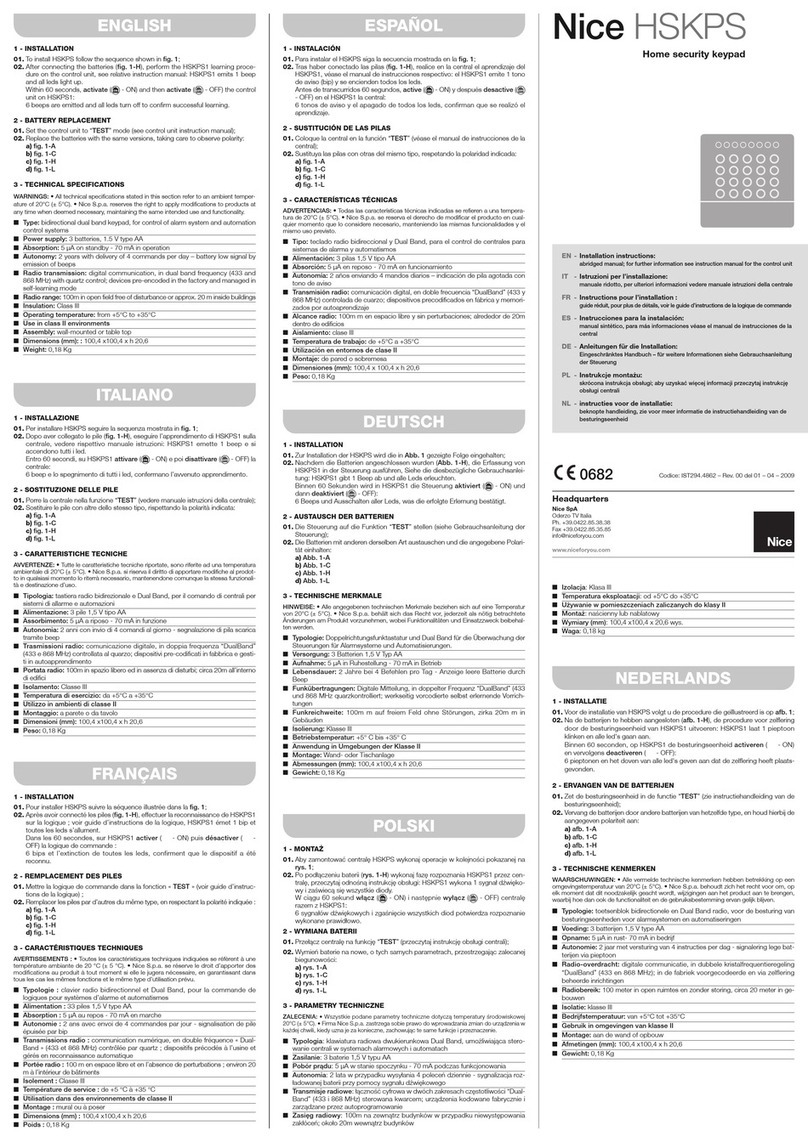
Nice
Nice HSKPS1 installation instructions
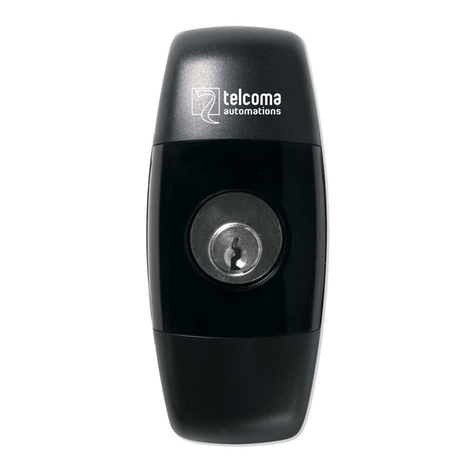
Telcoma
Telcoma APRO quick start guide
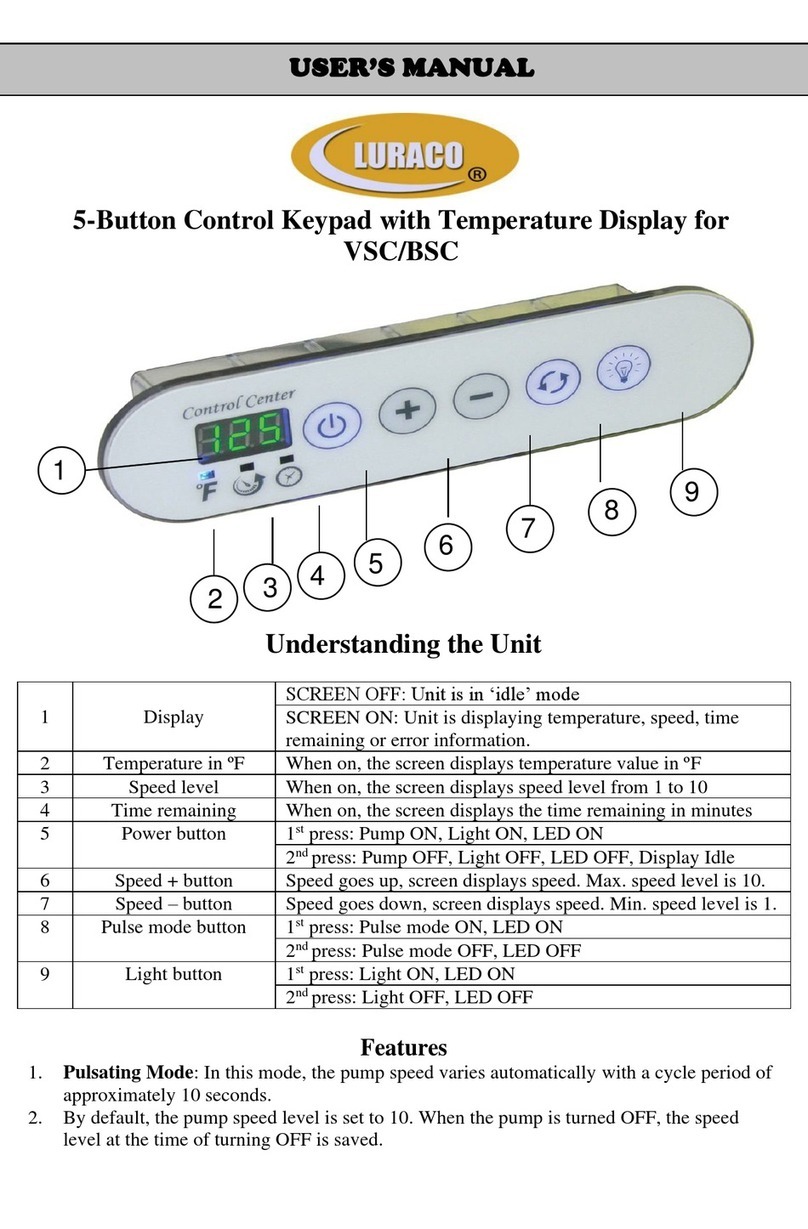
Luraco
Luraco VSC user manual
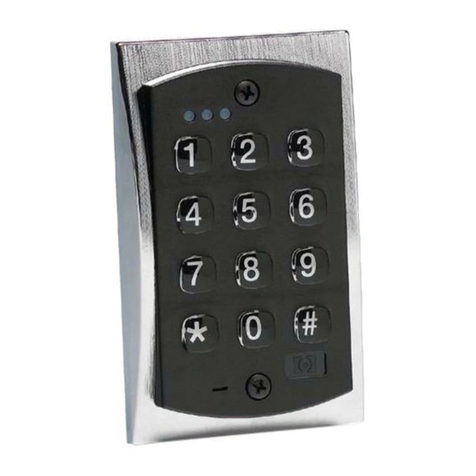
Door-Gard
Door-Gard 2000e Installation & programming

Honeywell
Honeywell 6150 - Ademco Fixed - Display Keypad Installation and setup guide
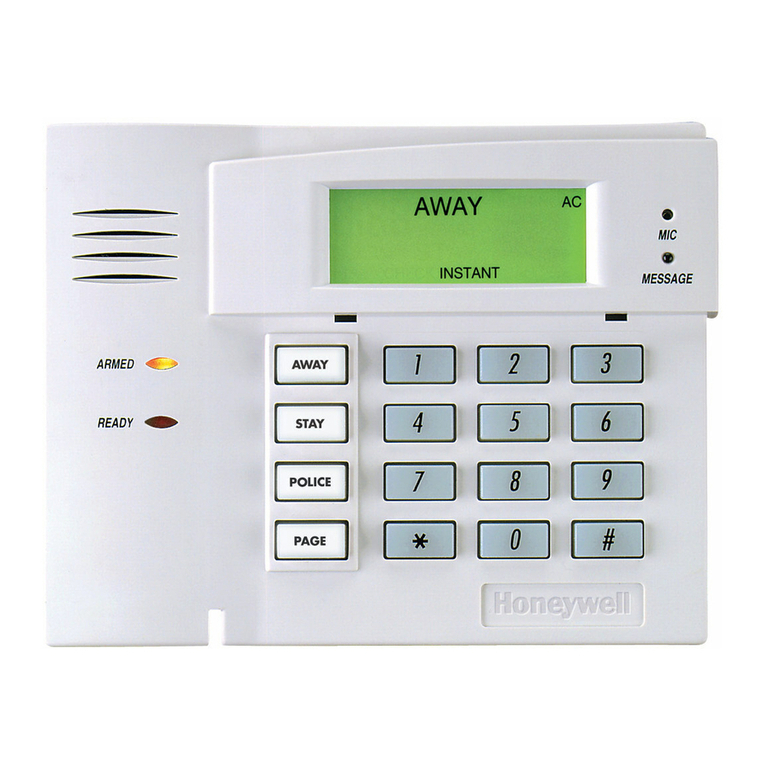
Honeywell
Honeywell ADEMCO 5828 Installation and setup guide
